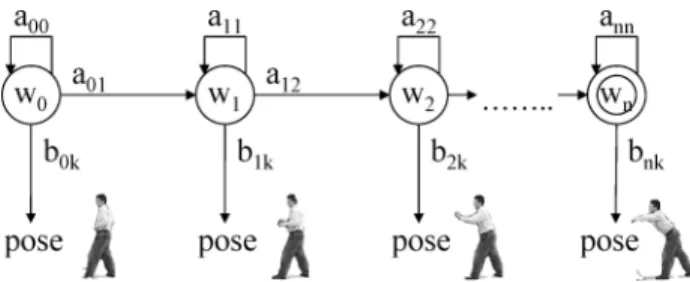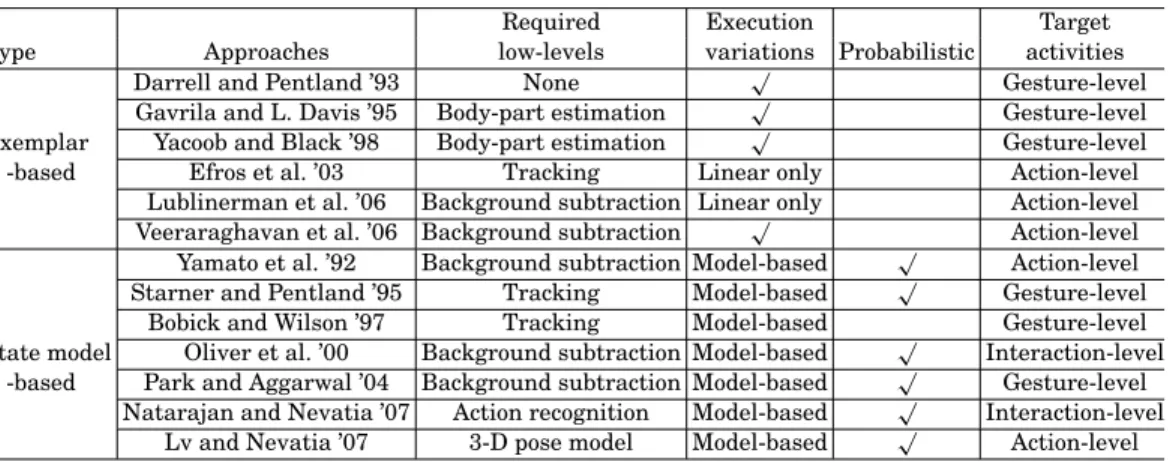In addition to pure 3-D spatial representation, there are several variants of spatiotemporal representation. This means that each of the activity recognition announcements with spatio-temporal approaches is assigned to a slot corresponding to a specific pair (presentation, recognition). Action recognition with spatio-temporal volumes. The core of recognition using spatiotemporal volumes lies in measuring the similarity between two volumes.
At each location of the volume (ie (x, y, t)), they extracted a small space-time patch around the location. Comparison. Table I compares the capabilities of the spatiotemporal approaches reviewed in this article.
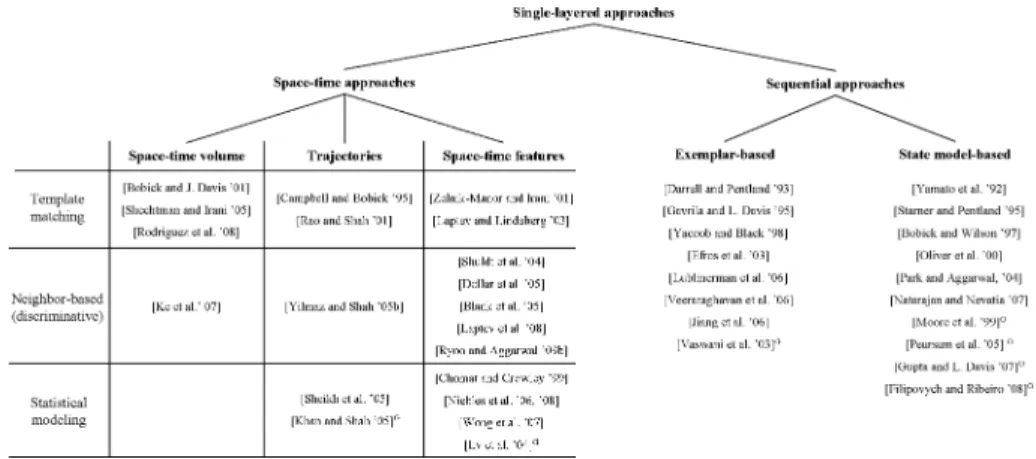
Sequential Approaches
The main limitation of the space-time feature-based approaches is that they are not suitable for modeling more complex activities. If their similarity is high enough, the system is able to infer that the given input contains an execution of the activity. When a new input is provided to the system, their system calculates the coefficients of the activity basis while taking into account transformation parameters such as scale and speed variations.
The model is one of the simplest cases among HMMs, which are designed to be strictly sequential. For each model, the probability that the model generates an observed sequence of feature vectors is calculated to measure the likelihood between the action model and the input image sequence. Once each of the HMMs is trained, they are used to recognize activities by measuring the probabilities between a new input and the HMMs solve the evaluation problem.
2000] built a variant of the basic HMM, the coupled HMM (CHMM), to model human-human interactions. In particular, the recognition of the interactions of two persons, whose sequential structure is important, was attempted in Oliver et al. On the other hand, state-based approaches are able to make a probabilistic analysis of the activity.
One of the limitations of the state-based approaches is that they tend to require a large number of training videos as the activity they want to recognize becomes more complex.

HIERARCHICAL APPROACHES
- Statistical Approaches
- Syntactic Approaches
- Description-Based Approaches
- Comparison
With the top layer HMMs, group activities such as monologue, discussion and presentation have been represented and recognized in terms of the atomic actions. The production rules of CFGs naturally lead to a hierarchical representation and recognition of the activities. Their grammar associates semantic tags and conditions with the production rules of the SCFG, enabling the recognition of more descriptive activities.
Therefore, recognition of the activity is performed by searching for the subevents that satisfy the relations specified in its representation. Atomic-level actions were manually marked from the video in the experiments; the system was able to recognize the activities even when one of the atomic actions was not provided. A Bayesian belief network is constructed for the recognition of the activity, based on its temporal structure representation.
The root node of the belief network corresponds to the high-level activity that the system wants to recognize. Other nodes correspond to the occurrence of sub-events or describe the temporal relationships between sub-events. 2004] took advantage of Petri nets to represent and recognize human-vehicle interactions, similar to Ivanov and Bobick [2000].
One of the limitations of description-based approaches is that they are largely deterministic and are fragile when their low-level components are noisy.
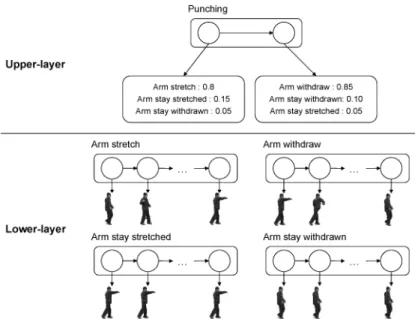
HUMAN-OBJECT INTERACTIONS AND GROUP ACTIVITIES
Recognition of Interactions between Humans and Objects
While we provide an overview of general human-object recognition approaches, we specifically focus on approaches that analyze interactions between object recognition, motion estimation, and activity level analysis toward robust recognition of human-object interactions. The most typical human-object interaction recognition approaches are those that ignore interactions between object recognition and motion estimation. They have made object recognition and motion estimation independent or have made it so that motion estimation is strictly dependent on object recognition.
On the other hand, several researchers have studied relationships and dependencies between objects, motion and human activities to improve both object recognition and activity recognition [Moore et al. Usually, this system performs the object recognition first and then estimates human activities with objects by depending on the object recognition results, as most other researchers have done. Finally, object-based evidence is integrated with action-based evidence by using a Bayesian network to determine the final object class, recovering from object recognition failure.
They pointed out that cues to the appearance (i.e., shape) of objects are unreliable due to differences in scale and viewpoint, and presented object recognition based solely on activity information. 1999; Gupta and Davis 2007] Ryoo and Aggarwal's object recognition and motion estimation components were designed to help each other. Furthermore, their system was designed to compensate for object recognition errors or motion estimation errors using probabilistic high-level activity recognition results.
This means that the object recognition and motion estimation components not only help each other, but also get feedback from the high-level activity recognition results for improved recognition.
Recognition of Group Activities
From left to right, pictures of group activities: group holdups, group burglaries in an office, group burglaries in a store, group fights, and group arrests. Gang theft is a situation where one thief takes an item while other thieves distract its owners. Their approach corresponds to the category of sequential approaches based on single-layer exemplars presented in Section 2.1.3. Similarly, Khan and Shah [2005] recognized a group of people parading by analyzing the general movement of group members.
Finally, Ryoo and Aggarwal [2008] developed a general representation and recognition methodology that is able to handle different types of group activities. Their approach is a description-based approach (Section 3.3), and various classes of group activities, including group actions (e.g., marching), group-group interactions (e.g., group stealing ), group-person interactions (eg, signal marching), and intragroup interactions (eg, intragroup fights) are represented and recognized with this system. They used universal (∀) and existential (∃) quantifiers to describe subevents (usually activities of individuals) that must be performed by each member of a group or by all members of a group.
By attaching the universal and existential quantifiers to the participating group members, their system was able to represent most of the group activities recognized by earlier researchers. The first class of activities that we discussed above is represented by attaching an existential quantifier to each actor in the group activity. The second class of activities is represented by using the universal quantifier and by placing spatial restrictions on the group.
Additionally, high-level group activities with complex structures that previous methods had difficulty representing and recognizing, such as "a thief stealing an object while other thieves distract the owners" or "police arresting a group of criminals", have been made. successfully represented and familiar with their system.
DATASETS AND REAL-TIME APPLICATIONS
Datasets
The authors sampled each group member's trajectory and analyzed their activities by fitting a 3-D polygon to check for group stiffness. What we should note is that these datasets are designed to verify the classification ability of the systems on simple actions. Each video of the data sets contains only the execution of one simple action performed by a single actor.
Most of the systems tested on the Weizmann dataset have produced successful results, mainly due to the simplicity of the dataset. Surveillance Data Sets. On the other hand, the PETS datasets (i.e., the datasets provided during the PETS workshops on and other similar datasets. Only the results from the systems with the usual experimental settings, the original 16 training-9 test setting [Schuldt et al .
Ryoo and Aggarwal 2009b] used the same cube features, and most of the other systems developed their own features to recognize the actions. The camera viewpoints are similar to those of typical CCTVs, and even multiple camera viewpoints are provided in some of the datasets. In the PETS 2006 dataset, 7 long video sequences were provided from each of the 4 different viewpoints.
They focused on human-luggage interactions: two sequences of general loitering, four sequences of baggage theft, and two sequences of baggage abandonment similar to those of the PETS 2006.
![Fig. 15. Example snapshots from the KTH dataset [Schuldt et al. 2004] ( c 2004 IEEE).](https://thumb-ap.123doks.com/thumbv2/123dok/10238860.0/33.918.185.724.177.238/fig-example-snapshots-kth-dataset-schuldt-et-ieee.webp)
Real-Time Applications
Similar to the PETS datasets, the recently introduced i-Lids dataset focuses on the problem of abandoned luggage. There was a real-time abandoned baggage detection competition at the AVSS 2007 conference with the dataset [Venetianer et al. Several works have been published that test their systems on these surveillance datasets [Lv et al.
However, they lack generality in a certain respect, as they are very much oriented towards surveillance applications. They are also different from the datasets in Section 5.1.2, as camera viewpoints move frequently and background information is rarely provided. Their approach can be seen as a sequential exemplar-based approach similar to Efros et al.
Several learning algorithms were applied to the low-dimensional trajectories, and the Gaussian mixture model was adopted for classification. Instead of making the algorithms simpler, they focused on the fact that modern hardware is capable of supporting expensive computational processing. Modern graphics cards are composed of multi-core GPUs, which suggests that they are capable of performing repetitive calculations in parallel.
This implies that they are suitable for the parallel processing of many computer vision algorithms that analyze images and videos (e.g. a GPU-based SIFT feature extraction).
CONCLUSION
InProceedings of the IEEE Conference on Computer Vision and Pattern Recognition (CVPR).IEEE, Los Alamitos, CA. InProceedings of the IEEE Conference on Computer Vision and Pattern Recognition Workshop (CVPRW).IEEE, Los Alamitos, CA. In Proceedings of the IEEE International Conference on Computer Vision (ICCV).IEEE, Los Alamitos, CA, 742.
In Proceedings of the IEEE International Conference on Computer Vision (ICCV).IEEE, Los Alamitos, CA. In Proceedings of the IEEE International Conference on Computer Vision (ICCV).IEEE, Los Alamitos, CA, 432. InProceedings of the IEEE International Conference on Computer Vision (ICCV).IEEE, Los Alamitos, CA.
In Proceedings of the IEEE Conference on Computer Vision and Pattern Recognition (CVPR).IEEE, Los Alamitos, CA, 469–474. In Proceedings of the IEEE International Conference on Multimodal Interfaces (ICMI).IEEE, Los Alamitos, CA, 3–8. In Proceedings of the IEEE Conference on Computer Vision and Pattern Recognition (CVPR).IEEE, Los Alamitos, CA, 1709–1718.
Proceedings of the IEEE Conference on Computer Vision and Pattern Recognition (CVPR), IEEE, Los Alamitos, CA, 379–385.

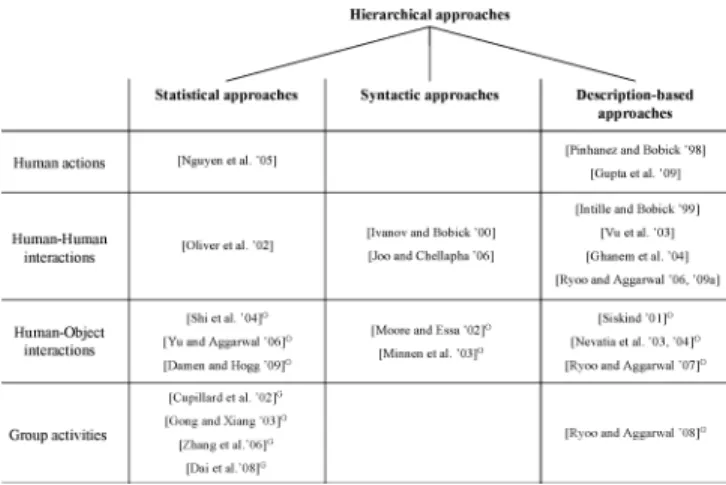
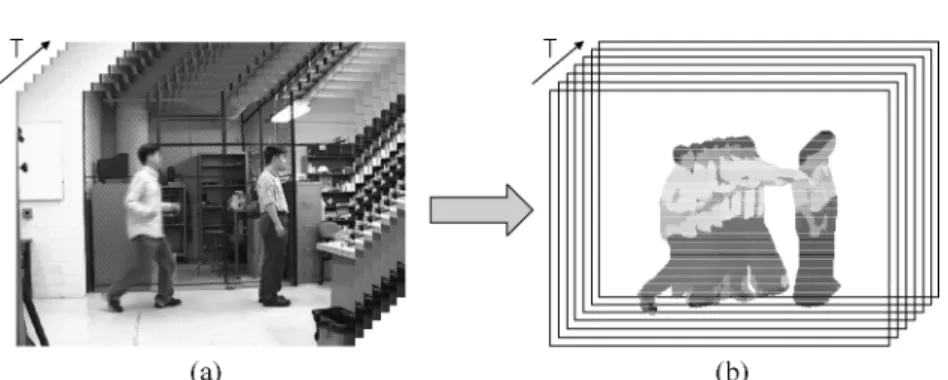
![Fig. 5. Examples of space-time action representation: motion-history images from Bobick and Davis [2001]](https://thumb-ap.123doks.com/thumbv2/123dok/10238860.0/7.918.326.589.173.535/examples-action-representation-motion-history-images-bobick-davis.webp)
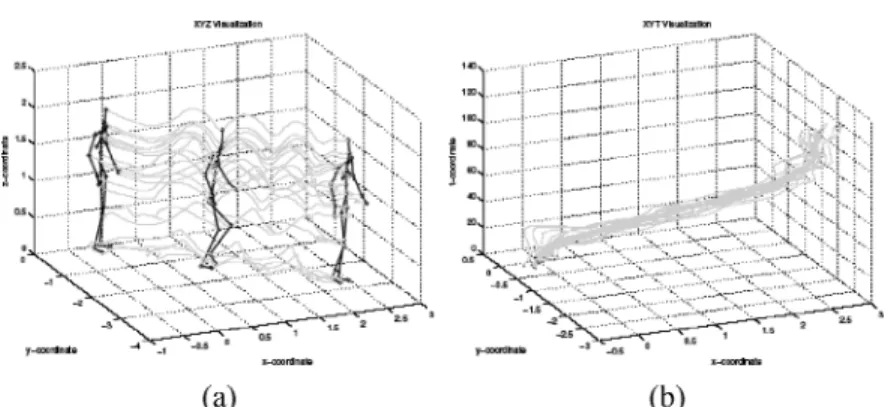
![Fig. 7. Example 3-D space-time local features extracted from a video of the human action of walking [Laptev and Lindeberg 2003] ( c 2003 IEEE), and features from a mouse movement video [Dollar et al](https://thumb-ap.123doks.com/thumbv2/123dok/10238860.0/11.918.227.693.177.374/example-features-extracted-walking-laptev-lindeberg-features-movement.webp)
